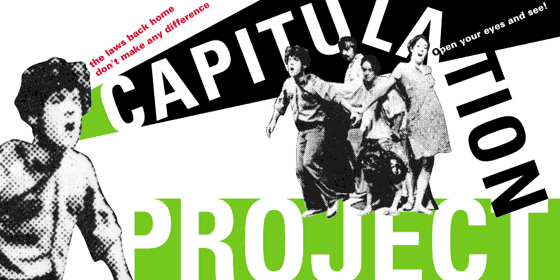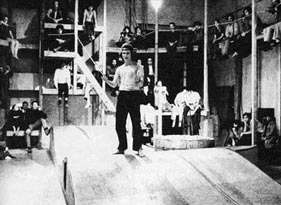 |
Our project for the September,
2003, exhibit at Berlin’s
Play-gallery for still and motion pictures is a continuation of our two
previous works, “Affection riposte” (Geneva, 2001), and “Internment
Area” (Stuttgart, 2002): we will use a cultural event from the
past in order to interrogate the present. The end result will be a
video installation that juxtaposes film and set within the gallery
space.
“
Capitulation Project” takes as its starting point “Commune,” a
performance staged in February, 1971, by New York’s Performance
Group. Since the mid-1960s, the codes of traditional theater were being
shattered; a host of companies was working at the fringes of the medium
and experimenting with new forms intended to engender social change.
Gone were playwrights, characters, and passive viewers sitting in their
chairs; these groups favored collective creation, broke taboos by performing
in the nude, reclaimed a space for social critique, and brought politics
and current events onto the stage; they drew inspiration from the liberating
force of primitive ritual.
One sequence from “Commune” fully evokes the potential
of this era. The performers here demanded active participation from
the
audience. The scene enacted questioned those assembled and relied on
audience reaction in order for the action to unfold; some of the viewers
had to join the performers. Using unexpected motion on the stage, debates,
and interruptions in the performance, the troupe tested four possible
endings for this sequence over the course of several months.
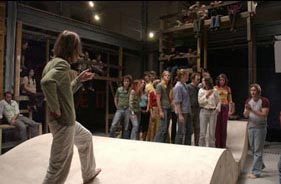 |
In “Capitulation Project” we take up the part of this performance
where the continuity of the action was most threatened, and we imagine,
thirty years later, a fifth version.
For this new version, we return to the event that inspired the sequence.
This piece of history limits the possibilities of representation. The
event in question is a massacre of several hundred Vietnamese civilians
by the American Army in the village of My Lai.
Three years passed between the time the acts were committed and the
court-martial that took place in the United States at the time of the
performance.
The revelation of these atrocities provoked a social trauma. On the
morning of March 16, 1968, Charlie Company of the 11th Brigade attacked
the hamlet
of My Lai in the South Vietnamese rebel province of Quang Ngai. The
soldiers met with no resistance from the enemy. They burned the entire
village,
systematically killing women, children, and the elderly. Part of the
company was charged with the task of gathering civilians at the edge
of a trench so that Lieutenant Calley and his men could execute them
at point-blank range and dispose of the bodies.
To stage the My Lai massacre, the performers made use of material from
the media: accounts of the event from newspapers, interviews from the
television networks. The audience evoked the Vietnamese villagers while
a performer announced news from the ongoing trial, or while another
became a reporter and questioned a “soldier” about the acts committed: “How
do you shoot babies?” “I don’t know. It seemed like
it was the natural thing to do at the time.”
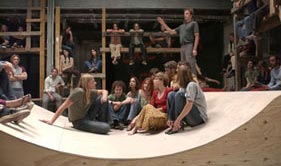 |
The set design for the performance was rudimentary: no weapons, no
blood, no decorations, only a long, raised strip of wood shaped like
a sine
curve, evoking both a wave and rolling hills. The audience was seated
at various heights on a wooden scaffolds that surrounded the wave,
the ensemble forming a kind of agora.
For the filming, we will recreate the scenery from this performance.
Some thirty extras will be placed on the scaffolds while the players
will take on the roles of the original performers, becoming reporters,
soldiers, and officers; they will heckle the audience, and the audience
will take part in the action.
We will need a rudimentary staging to counter the kinds of spectacular
images produced by the film industry and by the media. Vietnam has
by now become a cinematic genre, while the media today fabricate conflicts
in advance.
Taking a few steps back in time to recollect a conflict without the
strategies in use today will allow us to see how acts of war are a
function of their
mediation.
By proposing a fifth version of the My Lai sequence, we are also effecting
a displacement in terms of language. This fragment of the performance,
which we will reenact based loosely on photographic documents and reports,
will then become the subject of a film. It will be mediated by the
language of the cinema (framing, editing) and by the specific circumstances
of
the screening in the gallery space before it reaches our audience.
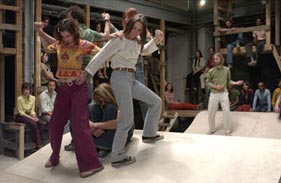 |
The fragment will last some fifteen minutes and will be filmed in 16
mm with live sound. Beyond the atmosphere of an audience incited by
heckling from the performers, beyond the eruption of simultaneous action
in several
places, the film will take stock of the time that has passed, and of
the repetition of such atrocities.
The distancing effect of the film on the performance will take on its
own meaning in the installation as space once again comes to signify
a relationship. The combination of the large-format projection of the
film with the scaffolds constructed for visitors in front of the screen
will create a mirror effect. This wooden scaffolds appears in the film,
and it is used by the audience, which in turn becomes, in the context
of the installation, the object of the gaze.
Frédéric Moser & Philippe
Schwinger
Berlin, Februar 2003
|
